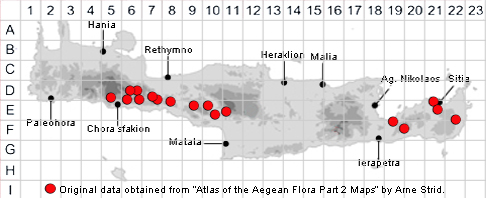SPECIES DESCRIPTION
PETRORHAGIA CANDICA
Family and Genus:- See- CARYOPHYLLACEAE/Sect. PSEUDOTUNICA
Common Names:- None
Homotypic Synonyms:- Dianthus candicus, Fiedleria candica.
Meaning:- Petrorhagia (Gr) Rock-bursting.
Candica (L) From Crete, Cretan
General description:- Perennial, glabrous or glandular-pubescent.
Stems:-
1) Up to 20 cm.
Leaves:-
1) Linear to lanceolate, 3-veined.
Flowers:-
1) Inflorescence, lax.
2) Pedicels, up to 20 mm.
3) Calyx, 3-4·5 mm.
4) Calyx-teeth, triangular-oblong, ± acute or mucronate, 3-veined, the lateral veins
sometimes weak.
5) Petals, 4·5-7 mm, oblong-spatulate, distinctly emarginate, white, with pink
veins.
Fruit:-
1) Seeds, 1·5 mm; black, smooth with thin margins.
Key features:-
1) Calyx-teeth, triangular-oblong, ± acute or mucronate; 3-veined, the lateral veins
sometimes obscure near the apex.
2) Petals, white, with dark violet veins beneath.
3) Seeds, c. 1·5mm, black, smooth.
Habitat:- Rocky and gravelly slopes with dry open shrubby vegetation and open
coniferous woodland, dolines. (0-)300-1500 m. mainly on limestone.
Distribution:- Endemic Crete
Flowering time:- May-July, occasionally later.
Photos by:- Fotis Samaritakis
